
In a world that is changing at a fast pace under the increasing weight of technology, how to stay in the race and renew its know-how? Let us rely on collective intelligence and develop teamwork, answer more and more institutions of higher education and companies. That’s how Stanford was born in the 80’s, design thinking , a problem-solving method that brings together expertise from a variety of backgrounds, from engineering to art, to management.
The number of steps can vary, but in all cases, it is based on the needs of the people concerned. Is the process transposable to the school world, where individual learning takes precedence? In Ahmedabad, India, Kiran Bir Sethi has shown that it is possible: with Device for Change, his students realize projects based on issues that affect them. Driven by the Synlab teacher network, the teacher network “Builders of possibilities” is the adaptation of this approach to the French school context.
There are infinite variants to a “Builders” project as the theme and the context of the process may differ from one class to another. For example, Sara Horte’s class in Beaulieu-sous-la-Roche tackled waste pollution, as shown by Judith Grumbach’s short film, There is no age to change the world , released in 2018. The opportunity to focus on the benefits of teamwork.
An exchange of know-how
These approaches of Design Thinking, which we see at work in the “Builders of Possible” approach, are based on old educational logic. They are mainly from the work of John Dewey (1859-1952), American philosopher and pedagogue, author of a formula that became famous: “learning by doing”. From John Dewey’s pedagogical work, we mainly remember the project approaches that consist in convincing the participants of the importance of their commitment, however modest. The challenge of teamwork is not so much to divide tasks as to be able to pool diversified skills.
By cooperating, students will be able to:
- acquire transversal skills, which they will be able to develop in different environments and disciplines: to speak in public, write a report, register their action in a collaboration …
- make learning transfers, that is to say, reuse in new contexts school knowledge discovered through lessons and exercises – and thus consolidate them. It may be to grant the participles, to draw the pattern of a solid, to identify the limits of fossil fuels, to understand a text in English …
Combined with coherent pedagogies, this way of organizing students ‘work is able to improve the students’ sense of school activity and to participate in the building of social relationships.
An impact on the motivation
Whether open formats such as “Builders of possible” or devices on a previously defined theme, learning by project can increase the involvement of the student, develop cooperation, but also to improve the quality of learning.
But learning in a transversal way by contextualizing several skills and subject knowledge is not only interesting from the point of view of motivation and learning. Some studies also show that such devices can increase students’ sense of self-efficacy (SEP). SEP refers to an individual’s beliefs about their ability to successfully complete a task, learning, challenge, or change.
A high SEP student will feel empowered to exercise control over events by mobilizing motivation and cognitive resources, while putting in place the actions necessary to achieve their goals. This dimension has a strong influence on students’ choice of activities, their investment in school, the persistence of their efforts and their emotional responses to obstacles. Quite logically, progress in MS also influences the progression of educational outcomes.
Another posture for teachers
The SEP is at the center of project-based learning, and in particular the “builders of possibilities” system, since students choose the project they are going to work on and use disciplinary knowledge in new contexts, thus having additional opportunities to take action. confidence in their ability to do things, to succeed.
This is what we were able to show in a research-action conducted this year with students who have conducted a project Builders of possible. These results would confirm the interest of this type of approach to promote student learning. Although this is only a first study and the results will have to be confirmed, these observations are consistent with the actual structure of the device, but also with the feedback that teachers have been making since the device exists in France.
However, it is not always easy to set up this kind of device. Beyond the confidence of the teacher in the ability of students to complete the process, learning by project requires changing posture (transition to a role of facilitator), but also to establish a climate favorable to collaboration, which is not always easy. In addition, it is necessary to be able to integrate learning from the program to the project, while ensuring the level of difficulty of the tasks performed by the students and the level of autonomy of the latter. But once these issues are exceeded, the benefits are at the rendezvous, for students as for their teachers.
Author Bio: Sylvain Connac is an Associate Professor at Paul Valéry University – Montpellier III
Article written by several hands by Bastien Wagener, Sylvain Connac and the network team Builders of Possible (Alexia Dugény, Sara Horte, Katarina Kordulakova)